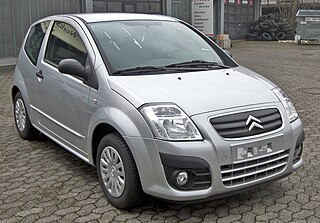
The Citroën C2 is a supermini that was produced by the French manufacturer Citroën, with production starting August 2003. It replaced the Citroën Saxo and was built at the Aulnay plant, on the outskirts of Paris. The Citroën C2 was discontinued in October 2009, and replaced by the Citroën DS3 in January 2010.
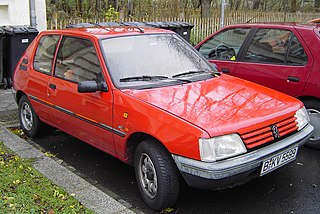
The Peugeot 205 is a supermini (B-segment) car produced by the French manufacturer Peugeot from 1983 to 1999.

The Citroën Visa is a five-door, front-engine, front wheel drive supermini manufactured and marketed by Citroën from 1978 to 1988 in gasoline and diesel variants. 1,254,390 examples were ultimately manufactured over a single generation, with a single facelift (1981). China has also assembled the car as the Liuzhou Wuling LZW 7100 minicar. Production started in 1991 and finished in 1994.

Panhard was a French motor vehicle manufacturer that began as one of the first makers of automobiles. It was a manufacturer of light tactical and military vehicles. Its final incarnation, now owned by Renault Trucks Defense, was formed by the acquisition of Panhard by Auverland in 2005, and then by Renault in 2012. In 2018 Renault Trucks Defense, ACMAT and Panhard combined under a single brand, Arquus.
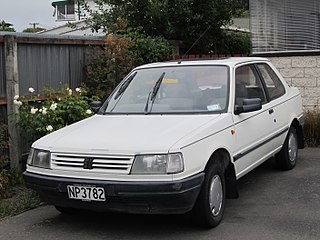
The Peugeot 309 is a small family car that was manufactured between 1985 and 1994 in England, Spain and France by PSA Peugeot Citroën. It was originally intended to be badged as a Talbot and, as development progressed, to be called the Talbot Arizona.

The Peugeot 104 is a supermini car produced by the French company Peugeot between 1972 and 1988. It was designed by Paolo Martin was initially only sold as a four-door saloon car, with a three-door hatchback variant introduced in 1974 and a five-door hatchback version replacing the saloon in 1976. The 104 was the first model produced at the company's Mulhouse plant. It was also the first new Peugeot introduced since 1955 not to be offered in a diesel version.

The Talbot Tagora is an executive car developed by Chrysler Europe and produced by Peugeot Société Anonyme (PSA). The Tagora was marketed under the Talbot marque after PSA took over Chrysler's European operations in 1979. PSA presented the first production vehicle in 1980 and launched it commercially in 1981. The Tagora fell short of sales expectations, described as a "showroom flop" just a year after its launch, and PSA cancelled the model two years later. Fewer than 20,000 Tagora models were built, all of them at the former Simca factory in Poissy, near Paris, France.

The Peugeot 607 is an executive car produced by the French manufacturer Peugeot from September 1999 to June 2010.
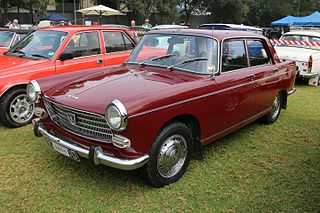
The Peugeot 404 is a large family car produced by French automobile manufacturer Peugeot from 1960 to 1975. A truck body style variant was marketed until 1988. Styled by Pininfarina, the 404 was offered initially as a saloon, estate, and pickup. A convertible was added in 1962, and a coupé in 1963. The 404 was fitted with a 1.6 litre petrol engine, with either a Solex carburetor or Kugelfischer mechanical fuel injection or a 1.9 litre diesel engine available as options. Introduced at the Paris Motor Show as an option was the inclusion of a 3-speed ZF automatic transmission, similar to the unit already offered on certain BMW models, as an alternative to the standard column-mounted manual unit.

The Citroën Élysée is a small family saloon car produced for the Chinese domestic market by the Dongfeng Peugeot-Citroën Automobile, a joint venture between the French PSA Group (Peugeot-Citroën) and the Chinese manufacturer Dongfeng Motor. Production commenced in June 2002.

The Renault 14 is a compact car produced by the French manufacturer Renault between 1976 and 1983. It was first shown in January 1976 with production beginning in June of that year.
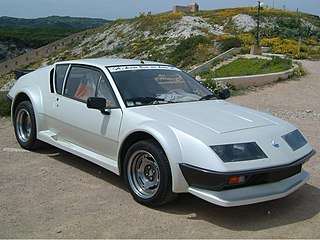
The Alpine A310 is a sports car built by French manufacturer Alpine, from 1971 to 1984.

Solex is a brand name owned by a subsidiary of Italian automotive parts manufacturer, Magneti Marelli. The original Solex company was French-owned and produced carburetors and gasoline powered bicycles.

The PSA X engine is a family of internal combustion engines used in Citroën, Peugeot, Talbot and Renault automobiles. The X family was mainly used in superminis and the entry level models of midsize vehicles. It was designed and manufactured by the company "Française de Mécanique", a joint venture created by Peugeot and Renault in 1969, and built in Douvrin in northern France. It is commonly called the "Suitcase" engine, the "Douvrin" nickname being commonly used for the bigger 2.0-2.2 liter J-Type engine, which was also built in Douvrin.
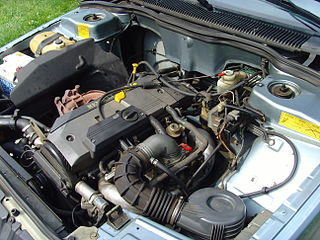
The Douvrin family is an all-aluminum inline-four automobile engine designed in the early 1970s and produced from 1977 to 1996 by Compagnie Française de Mécanique, a joint-venture between PSA and Renault located in the town of Douvrin in northern France. This engine is designed by the engineer Jean-Jacques His. It was produced in the same factory as the PRV V6, which also is sometimes known outside France as the "Douvrin" V6. The Douvrin engine is also referred to as the ZDJ/ZEJ engine by Peugeot, and as the J-type engine by Renault.
Renix was a joint venture by Renault and Bendix that designed and manufactured automobile electronic ignitions, fuel injection systems, electronic automatic transmission controls, and various engine sensors. Major applications included various Renault and Volvo vehicles. The name became synonymous in the U.S. with the computer and fuel injection system used on the AMC/Jeep 2.5 L I4 and 4.0 L I6 engines.
France was a pioneer in the automotive industry and is the 11th-largest automobile manufacturer in the world by 2015 unit production and the third-largest in Europe. It had consistently been the 4th-largest from the end of World War II up to 2000. It is 16 % of sales of French manufactured products.
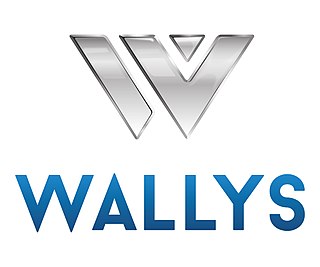
Wallyscar is a Tunisian car manufacturer, founded in 2006 and based in Ben Arous. Production is 600 units per year. Wallyscar vehicles are mostly used and present in Africa, Europe and the Middle East. The company sells in Panama, France, Spain, Qatar and Morocco. Wallyscar cooperates with the French automobile company Peugeot, using a PSA 1.4-litre petrol engine in their vehicles. The company was founded by Zied Guiga. The company lays claims to importance to compliance with European standards, and focuses mainly on the idea of vehicles as recyclable and making noise. Corresponding parts suppliers are Citroën, Peugeot, VDO and UTAC. In the vehicle identification number, the Company uses the manufacturer code CL9.

The Renault Nervasport was a straight-eight engined sporting luxury automobile introduced by Renault in March 1932 and produced until 1935. It was based on the larger and heavier Nervastella. A more streamlined version called the Nerva Grand Sport appeared in 1935 and replaced the Nervasport, remaining in production until the summer of 1937. As with many Renaults during the 1930s, type changes as well as small often cosmetic facelifts and upgrades appeared frequently.

















